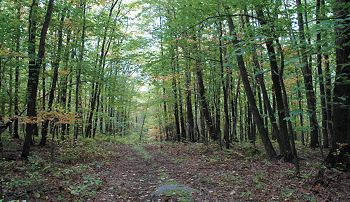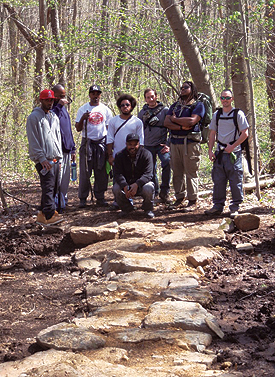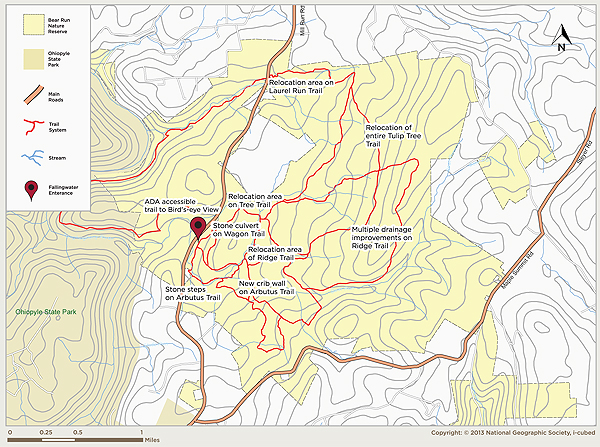Bear Run Trails Restored
Renovations on WPC’s Flagship Property

A group of stewardship staff and volunteers made it look deceivingly simple. They securely wrapped a three-foot-by-two-foot boulder with heavy-duty chain that fed into a manually operated hoist. While two members of the team prodded the boulder along with rock bars, another team member operated the winch, flipping and sliding the massive piece of stone into place by the side of a hiking trail.
Not every boulder would come along so peacefully. The stewardship team used various combinations of rock bars, hoists, chains, straps and rolling logs to coax thousands of pounds of stone along stream banks, through forests, and sometimes even up hills to their final resting places as part of culverts, retaining walls, and steps.
This was a typical workday for Western Pennsylvania Conservancy staff and volunteers as they undertook what is likely the most ambitious project the stewardship program has ever undertaken. The team recently wrapped up a six-year, $140,000 effort to overhaul a large portion of the 20 miles of trails on Bear Run Nature Reserve.
“This project required a significant time and financial investment, including more than 2,100 hours of volunteer time, nearly 800 hours of staff time, $55,000 from the state Department of Conservation and Natural Resources, and over $88,000 of additional funds, including $50,000 from one individual donor,” said Andrew Zadnik, WPC’s land stewardship manager. “The result is a sustainable trail system that is easier to navigate with more stable walking surfaces; drier, elevated walkways; stone steps and other features.”
Bear Run Nature Reserve is home to Frank Lloyd Wright’s Fallingwater. In 1936, the architect built Fallingwater at the site of the Kaufmann family’s mountain retreat. Then, in 1963, Edgar Kaufmann jr. entrusted the house and acreage around it to the Conservancy. In addition to providing a place for people to enjoy and appreciate nature, WPC intended the reserve, which has tripled in size over the last 50 years, to protect habitat for native plants and animals.

The Conservancy’s stewardship staff depended on the help of volunteers and contractors, such as partners from the Mount Washington Community Development Corporation.
“Bear Run Nature Reserve’s more than 5,000 acres are integral to biodiversity conservation in the Laurel Highlands and mid-Appalachian region,” Zadnik said.
The reserve is composed of mature forest featuring oak, cherry, tulip poplar and pure hemlock stands; and extensive rhododendron thickets. Habitat is provided for a diversity of forest-dwelling wildlife, including black bear, fisher, bobcat and more than 53 bird species. Four cold-water tributaries of the Youghiogheny River flow through the reserve: Crooked Run, Laurel Run, Bear Run (which gives the property its name) and Lick Run.
Yet there was room for improvement on the Bear Run reserve. A conservation plan, completed in 2007, called for significant trail improvements, including altering or closing trails that were overly stressing the local ecosystem.
“Sections of trail weren’t well laid out. They may have been aligned along existing logging trails or access roads which weren’t properly constructed to begin with,” said Brian Jones, a WPC land steward who’s responsible for Conservancy properties throughout the Laurel Highlands and farther east. “Or, they were aligned across the contours instead of following the contours. This resulted in unstable trails, erosion, and sedimentation of nearby streams.”
The Conservancy hired MTR Landscape Architects LLC and Tahawus Trails LLC to assess the trail system and draw up an improvement plan. By 2010, the collaboration completed the assessment and gave a number of detailed recommendations. The Conservancy prioritized the possible improvements based on required labor, trail connections, available funding, and other factors.
Significant fieldwork began in the spring of 2011, when a representative from Tahawus Trails showed staff and volunteers various trail building techniques. The consultant emphasized using native materials, mostly stone that workers would harvest from the reserve.
Staff used detailed work-logs that laid out the necessary improvements and changes, down to each foot of trail. These logs guided workers through the relocation of trails, the construction of culverts, the installation of steps and other renovations.
To complete the work, staff relied largely on volunteers – at least a dozen of them from WPC membership ranks and organizations such as the Keystone Trails Association. The Conservancy also hired others to help with trail building, including a crew from the Mount Washington Community Development Corporation.
An important aspect of the project was the creation of a trail that met the regulations set by the Americans with Disabilities Act. The team, with financial support from UPMC Health Plan, modified a nature trail leading to a popular overlook of Fallingwater called the Bird’s-eye View. The new route follows the existing path where possible, with switchbacks and resting areas according to ADA requirements.
In all, the team renovated more than eight miles of trails. Visitors will notice a new crib wall lining the bank of Bear Run, trails contouring along natural land formations, and a relocated trail that leads deep into the reserve.
And there’s more trailwork to be done, which will be accomplished over time as resources permit. In addition, other objectives described in the reserve’s conservation plan are still ongoing. For example, it calls for the long-term restoration of native forests on several old fields within the reserve. As an initial step, native trees were planted in 2008, which will take years to mature.

This map illustrates the 20-mile trail system at Bear Run Nature Reserve, including a selection of trail improvements.
